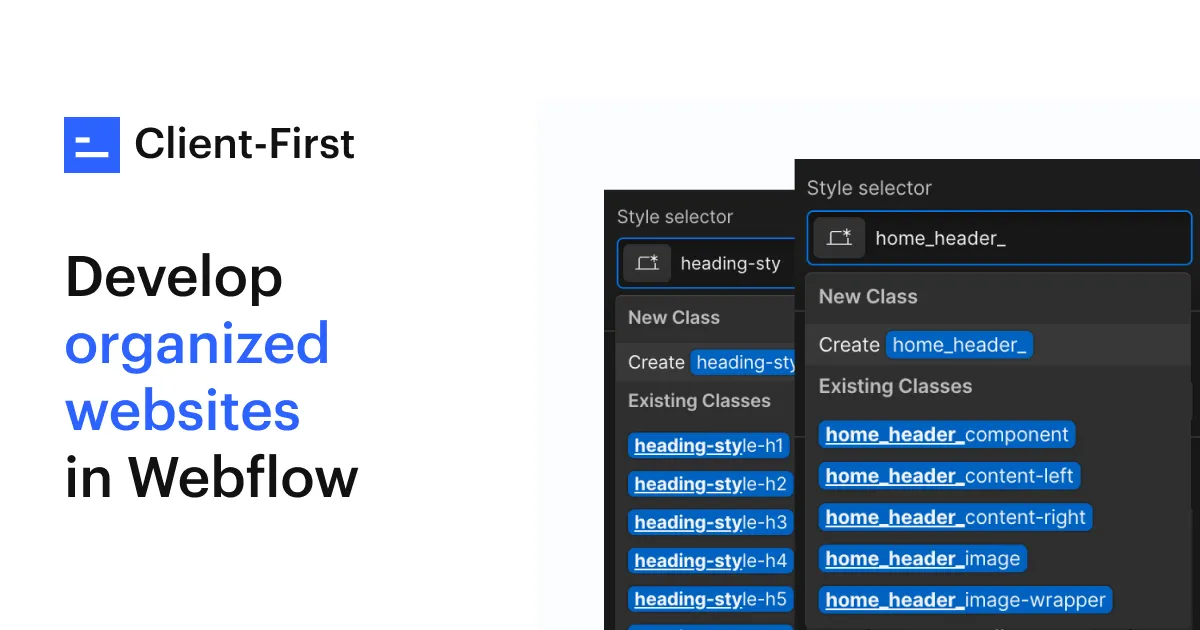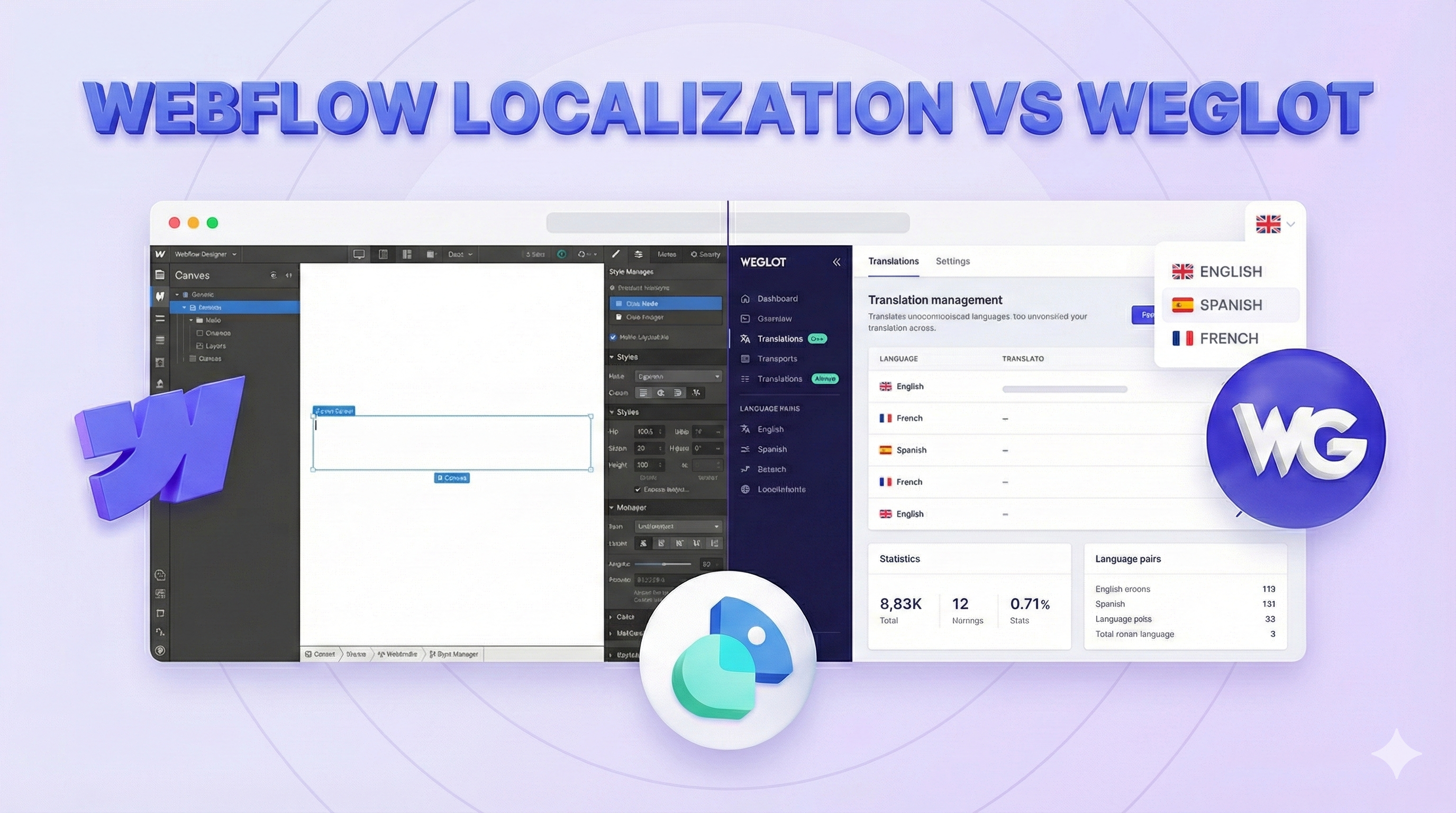When you have a Webflow site developed, two needs always come up: to obtain an aesthetic and efficient site, but also to be able to make it evolve easily without breaking everything. That's exactly what the method Client First Webflow allows you to do.
Created by Finsweet, a recognized no-code agency, this approach has changed the way Webflow sites are designed. It combines rigor, legibility and autonomy for teams as well as for customers.
First Webflow client: the method that changes everything
Clear and quick definition of the Client First system
Client First Webflow Is a method of structuring and naming classes on Webflow. It defines how to name, organize, and prioritize the elements of a site to make it logical and easy to maintain.
This approach is based on three simple principles:
- one consistent and standardized class nomenclature
- one readable and hierarchical HTML structure
- one careful management of spaces and styles through utility classes
The objective is clear: to make any Webflow project understandable, even by someone who did not participate in its creation.
Why has this method become a standard
Before Client First, each designer did “their own thing”: classes like.div1 or.section-hero2 accumulated without logic. The result: a site that is difficult to maintain, and almost unreadable for someone else.
Client First provided a common base. Today, it has become a standard adopted by the majority of Webflow agencies. Its logic makes code cleaner, facilitates collaboration, and makes life easier for customers.
When should I use Client First on Webflow?
The method is not just for agencies or experts. It applies to any Webflow project that must be sustainable, clear and scalable.
It is particularly useful:
- when several people work on the same site
- when the customer should be able to modify its content without risk
- when you want to ensure visual consistency across multiple pages
- when the project is likely to evolve over time
In other words, as soon as you want a professional, stable and well-structured site, Client First is a great base to work with.
Why use Client First on its Webflow site?
For businesses and customers
The advantage of the system is in its name: Client First.
This method makes the site easier to understand and manage.
The customer no longer needs a developer for each update.
With clear and consistent logic, it can:
- Easily find content blocks in the Webflow interface
- duplicate a section without risking breaking the style
- modify texts, images or buttons without touching the code
- make your site evolve without recoding each page
It is an approach designed to make the site remain accessible, stable and sustainable, even after delivery.
For Webflow designers and developers
On the technical side, Client First brings a welcome level of rigor.
Each class follows a predictable and understandable logic. The CSS code is lighter, the HTML structure is better organized, and the maintenance is faster.
This consistency allows an entire team to work on a project without confusion.
A new designer can take over the site immediately without having to analyze everything.
For SEO and performance
Client First is not limited to structure. It also improves the performance And the natural referencing (SEO).
A clear HTML hierarchy helps Google understand pages and better index content.
Cleaner code reduces the weight of the site and improves the loading speed.
In concrete terms, Client First promotes:
- better reading of H1, H2, H3 tags by search engines
- shorter and better optimized CSS
- a consistent display on all screens
- a smoother user experience
How does Client First work on Webflow?
A clear logic of structure and hierarchy
The method is based on a standardized and reusable architecture.
Each Webflow page follows the same hierarchy:
section > container > content-wrapper > heading > text
Each level plays a specific role:
- section : main block (example: Hero section)
- Container : limits the width of the content
- content-wrapper : groups texts, images and buttons
- Heading/text : main content
Here is a comparative example:
Element
Structure without method
Structure with Client First
Main section
div1
Section-Hero
Content block
Block-Blue
content-wrapper
Main title
Title-h1
Heading-Large
Paragraph
Paragraph-2
text-medium
Image
Image-hero
image-wrapper
This logic makes it possible to read the structure of a Webflow site at a glance.
The utility class system
Another pillar: the utility classes.
They are used to manage the most common CSS properties without multiplying styles.
Examples of classes:
- .padding-large: add a lot of interior space
- .margin-bottom-medium: create an average space under a block
- .text-size-small: Define a small text size
- .color-primary: apply the main color of the project
These classes can be reused on all pages. They guarantee visual coherence and speed up creation.
Common categories:
- Spacing : padding, margin, spacing
- Text : text-size, alignment, heading
- Colors : color-primary, color-secondary
- Display : flex, grid, align
- Size : width, height, max-width
Thanks to these classes, projects remain lightweight, logical, and quick to maintain.
The importance of global properties
Client First favors an approach global and standardized.
Instead of modifying an isolated element, we update a class that applies everywhere.
This ensures the visual coherence of the site and simplifies any evolution.
Key best practices:
- manage spacings with global classes
- use rem units for responsive scaling
- Define global colors to standardize the design
- prioritize text styles (heading, paragraphs, labels)
It is this rigor that makes the difference between a “clean” site and a site that is difficult to maintain.
How to apply Client First on your Webflow project
The key steps
- Download the official Finsweet documentation
- Import the Client First guide style into your Webflow space
- Name classes correctly from the start
- Use utility classes for spacing and colors
- Respect the section > container > content-wrapper structure on each page
- Manage global styles (text-size, color, spacing) consistently
Helpful tools and resources
- Client First (Finsweet) official documentation
- Webflow guide style ready to import
- Finsweet YouTube video tutorials and Webflow experts
- Free templates and clones based on Client First
These resources make it possible to adopt the method without starting from scratch.
What to remember about Client First on Webflow
Client First Webflow is above all a philosophy of rigor and clarity.
It provides both a solid structure for developers and a better understanding for customers.
To remember:
- a clear structure and logical hierarchy
- simple, reusable and consistent classes
- easy maintenance
- better readability of code and pages
- smooth collaboration between teams
- a faster and more SEO friendly site
Adopting Client First means professionalizing the way you build on Webflow and making each project more sustainable.
Chez Scroll, we use this method on all our Webflow projects to guarantee our customers sites that are fast, reliable and easy to evolve.
If you want a Webflow site built on a solid base, ready to last and perform, this is clearly the method to adopt.
FAQ: everything you need to know about Client First Webflow
1. What is the Client First method on Webflow?
It is a method of structuring and naming classes created by Finsweet to make Webflow projects more clear and consistent.
2. How do I install Client First on a Webflow project?
Just import the Official style guide proposed by Finsweet and to apply their class and structure logic.
3. What is the difference with a classical structure?
Client First brings a universal logic and documented, while classic naming depends on each designer.
4. Can Client First be combined with other CSS frameworks?
Yes, but class redundancies should be avoided to keep the structure clear and lightweight.
5. Does Client First improve Webflow performance?
Yes, thanks to optimized CSS, a clean hierarchy and faster code to load.
By adopting First Webflow Customer, you create sites that are stronger, easier to scale and more understandable for your teams and customers. It is a modern standard of the web to be integrated as soon as you design your next project.
Faq
C’est une méthode de structuration et de nomination des classes créée par Finsweet pour rendre les projets Webflow plus clairs et cohérents.
Il suffit d’importer le style guide officiel proposé par Finsweet et d’appliquer leur logique de classes et de structure.
Client First apporte une logique universelle et documentée, alors qu’un naming classique dépend de chaque designer.
Oui, mais il faut éviter les redondances de classes pour garder une structure claire et légère.
Oui, grâce à un CSS optimisé, une hiérarchie propre et un code plus rapide à charger.


.svg)


















.svg)
.svg)
.svg)